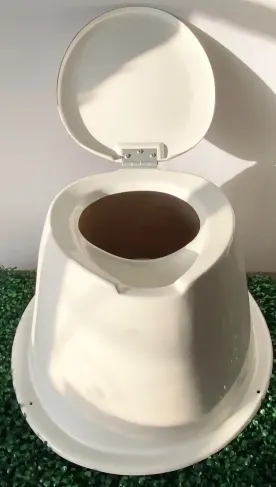

In a world where water scarcity is an increasing concern, dry toilets have emerged as an innovative and eco-friendly alternative. Unlike traditional systems, dry toilets operate without water, allowing for installation in any location—from rural areas to urban settings—without compromising the environment. Discover how these devices not only help conserve water but also offer numerous benefits for our health and the planet.
1. What is a Water Less Toilet and How Does It Work?
A dry toilet is designed to manage waste without using water. Instead of flushing waste into a drainage system, it is stored in a special compartment where it decomposes naturally, typically through composting. This process not only eliminates the need for water but also transforms waste into safe, reusable organic fertilizer, contributing to a sustainable nutrient cycle.
2. Water Savings: A Priority in Water-Scarce Areas
Every time we use a conventional toilet, it flushes away between 169 to 236 ounces of wáter per use. With a wáter less toilet, this water usage is eliminated. For regions facing water scarcity or where access to water is limited, water less toilets represent a vital option. In places like cabins, natural area facilities, and remote sites lacking water infrastructure, these toilets provide a completely self-sufficient and sustainable solution.
3. Reducing Pollution and Improving Waste Management
Since water less toilets are not connected to a drainage network, they eliminate the need to treat large volumes of contaminated water at treatment plants. This means fewer risks of sewage leaks and less pollution of rivers, lakes, and soils. Additionally, the composting process in these systems allows for the transformation of waste into nutrient-rich compost, promoting more efficient waste management and positively impacting local ecosystems.
4. Promoting Self-Sufficiency and Sustainability
With a water less toilet, each home, business, or institution can take responsibility for its own waste without relying on a drainage network. This represents a step toward self-sufficiency and sustainability by turning waste into resources, promoting nutrient recycling, and reducing the burden on conventional sanitation systems. Furthermore, this approach aligns perfectly with the concept of a circular economy by returning essential nutrients back to the soil.
5. Fostering an Eco-Conscious Culture
Adopting water less toilets demonstrates environmental responsibility and commitment to the planet’s future. These devices not only save water but also promote a cultural shift toward responsible resource use. As people discover the benefits of this system, environmental awareness grows, encouraging more individuals to make choices that benefit both their communities and the natural environment.
Is It Time to Switch to a Dry Toilet?
Water less toilets offer an effective and eco-friendly alternative for those seeking a more responsible lifestyle that is friendly to the planet. Whether in urban or rural areas, these devices provide a sustainable solution that reduces water consumption, prevents pollution, and encourages better resource management. If you’re ready to make a positive change, consider dry toilets: a small decision that can have a significant long-term impact on the environment.

